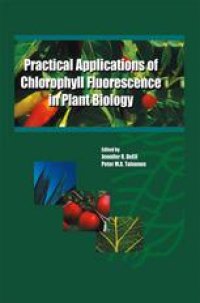
Ebook: Practical Applications of Chlorophyll Fluorescence in Plant Biology
- Tags: Plant Physiology, Plant Sciences, Ecotoxicology, Ecology
- Year: 2003
- Publisher: Springer US
- Edition: 1
- Language: English
- pdf
The technique of chlorophyll fluorescence has a relatively short history, beginning with the observations by Kautsky (Kautsky and Hirsch, 1931). Since that time there have been several· reviews devoted to the subject, with most of them highly theoretical (Bohlar-Nordenkampf and Oquist, 1993; Dau, 1994; Schreiber et aI. , 1994). There have also been many books devoted to generalized spectrophotometric and microscopic fluorescence techniques. However, to the best of our knowledge there has not been a book completely devoted to the practical applications and uses of chlorophyll fluorescence in plant biology. As techniques mature, applications multiply and so do their potential advantages. The chlorophyll fluorescence technique is maturing as can be seen in the increasing numbers of publications that are devoted to its use. Therefore, we considered that now was a good time to compile the existing knowledge for the applied use of this technique and provide a single volume to which a novice or experienced user could refer. Highly trained experts in the field of photobiology have primarily used the chlorophyll fluorescence technique in the past. In that work, understanding the mechanisms and controls of the photosynthetic processes was the main focus of activity and discussion. Much of the equipment used was highly specialized and expensive, or in some cases one-of-a-kind lab designed units. However, the development of several reliable commercially available chlorophyll fluorescence monitoring instruments has changed the potential user base for the technique.
The first two chapters of this book are devoted to provide a clear, understandable explanation of the theoretical basis for chlorophyll fluorescence analysis. The definitions and terminology that are specific to chlorophyll fluorescence analysis are included in this discussion, which leads to the bridging of chlorophyll fluorescence analysis to plant tissue condition status. Subsequent chapters focus on the monitoring of stress in the natural terrestrial and aquatic environments, assessing seedling quality in forestry, and postharvest quality in fruits and vegetables. A final chapter is devoted to a newly emerging use for the technique in plant breeding programs. It is the hope of the editors and authors that readers who have not used this technique will be encouraged to explore the possibilities in their area of study. For those who have used the technique previously, this book will offer some new insights, which may encourage development and/or refinement of approaches. This work will contribute to advances in the understanding of plant-environment interactions and hence to improvements in the environmental quality, as well as in forestry and agri-food industries.
The first two chapters of this book are devoted to provide a clear, understandable explanation of the theoretical basis for chlorophyll fluorescence analysis. The definitions and terminology that are specific to chlorophyll fluorescence analysis are included in this discussion, which leads to the bridging of chlorophyll fluorescence analysis to plant tissue condition status. Subsequent chapters focus on the monitoring of stress in the natural terrestrial and aquatic environments, assessing seedling quality in forestry, and postharvest quality in fruits and vegetables. A final chapter is devoted to a newly emerging use for the technique in plant breeding programs. It is the hope of the editors and authors that readers who have not used this technique will be encouraged to explore the possibilities in their area of study. For those who have used the technique previously, this book will offer some new insights, which may encourage development and/or refinement of approaches. This work will contribute to advances in the understanding of plant-environment interactions and hence to improvements in the environmental quality, as well as in forestry and agri-food industries.
Content:
Front Matter....Pages i-xvi
An Introduction to Chlorophyll Fluorescence....Pages 1-29
Chlorophyll Fluorescence: A General Description and Nomenclature....Pages 31-77
Applications of Chlorophyll Fluorescence in Forestry and Ecophysiology....Pages 79-124
The Application of Chlorophyll Fluorescence to Study Light, Temperature, and Drought Stress....Pages 125-150
Applications of Chlorophyll Fluorescence in Ecotoxicology: Heavy Metals, Herbicides, and Air Pollutants....Pages 151-184
The Application of Chlorophyll Fluorescence in the Aquatic Environment....Pages 185-202
Use of Chlorophyll Fluorescence in Postharvest Quality Assessments of Fruits and Vegetables....Pages 203-242
The Potential of Chlorophyll Fluorescence in Fruit Breeding....Pages 243-256
Back Matter....Pages 257-259
The first two chapters of this book are devoted to provide a clear, understandable explanation of the theoretical basis for chlorophyll fluorescence analysis. The definitions and terminology that are specific to chlorophyll fluorescence analysis are included in this discussion, which leads to the bridging of chlorophyll fluorescence analysis to plant tissue condition status. Subsequent chapters focus on the monitoring of stress in the natural terrestrial and aquatic environments, assessing seedling quality in forestry, and postharvest quality in fruits and vegetables. A final chapter is devoted to a newly emerging use for the technique in plant breeding programs. It is the hope of the editors and authors that readers who have not used this technique will be encouraged to explore the possibilities in their area of study. For those who have used the technique previously, this book will offer some new insights, which may encourage development and/or refinement of approaches. This work will contribute to advances in the understanding of plant-environment interactions and hence to improvements in the environmental quality, as well as in forestry and agri-food industries.
Content:
Front Matter....Pages i-xvi
An Introduction to Chlorophyll Fluorescence....Pages 1-29
Chlorophyll Fluorescence: A General Description and Nomenclature....Pages 31-77
Applications of Chlorophyll Fluorescence in Forestry and Ecophysiology....Pages 79-124
The Application of Chlorophyll Fluorescence to Study Light, Temperature, and Drought Stress....Pages 125-150
Applications of Chlorophyll Fluorescence in Ecotoxicology: Heavy Metals, Herbicides, and Air Pollutants....Pages 151-184
The Application of Chlorophyll Fluorescence in the Aquatic Environment....Pages 185-202
Use of Chlorophyll Fluorescence in Postharvest Quality Assessments of Fruits and Vegetables....Pages 203-242
The Potential of Chlorophyll Fluorescence in Fruit Breeding....Pages 243-256
Back Matter....Pages 257-259
....